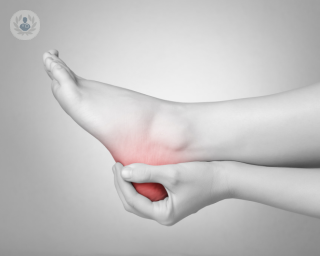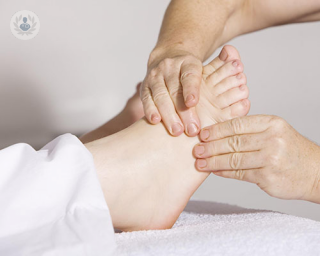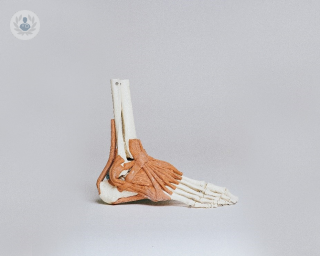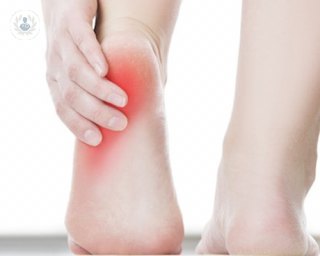What is plantar fasciitis?
Plantar fasciitis is the inflammation of the plantar fascia by overloading or stretching. The plantar fascia is a thick ligament in the sole of the foot which connects the heel with the toes. This inflammation causes pain as you walk about, usually first thing in the morning, which flares up when standing after sitting for a long period.
An orthopaedic specialist can help to treat plantar fasciitis.

What are the symptoms of plantar fasciitis?
Plantar fasciitis typically presents with several distinct symptoms, primarily centred around the heel:
Heel pain: The hallmark symptom is a sharp, stabbing pain in the heel, often most intense in the morning or after rest.
Aching and burning: Some individuals experience a dull, aching pain or a burning sensation in the heel, which can persist throughout the day.
Stiffness: The heel can feel stiff, making it difficult to flex the foot or point the toes, especially upon waking or after prolonged inactivity.
Swelling: In more severe cases, there may be slight swelling around the heel.
Tenderness: The affected heel and the arch of the foot become tender to the touch.
Radiating pain: Pain can radiate from the heel into the arch of the foot.
Aggravation with activity: Physical activities that strain the plantar fascia, like walking or running, can worsen the pain.
Relief with rest: Rest can alleviate the pain, with discomfort decreasing when off your feet.
How is plantar fasciitis typically diagnosed?
To diagnose plantar fasciitis, the patient’s clinical history is evaluated and a physical examination is performed. The examination determines which stage the plantar fasciitis is at. Following this, the specialist performs a gait analysis and evaluates whether the inflammation of the plantar fascia is related to the way the patient walks. An X-ray scan or MRI scan might be performed to rule out bone problems and potential pinched nerves.
What are the main causes of plantar fasciitis?
The causes of plantar fasciitis is when the tension on the tissue becomes too great, causing inflammation. It is more likely to occur in people who:
- do sports frequently
- are obese
- have a tight achilles tendon
- have foot arch problem
Can plantar fasciitis be prevented?
This can be difficult to prevent, however, maintaining a healthy weight can help reduce the chances of this developing. However, if you frequently do exercises such as running, dancing, or aerobics, plantar fasciitis can develop. In addition, checking that the ankle, Achilles tendon and calf muscles are flexible may help to prevent plantar fasciitis. It may also be helpful to stretch the plantar fascia in the morning before you get out of bed and to perform physical activities in moderation.
Treatments for plantar fasciitis
There are different treatments for this condition but the first option considered is conservative treatments, including rest, applying ice to the painful area and stretching over several months. Massaging and stretching the fascia, can help to provide symptoms relief.
Other, more novel techniques are infiltration of growth factors, intratissue percutaneous electrolysis (EPI) and shock waves, which have all been demonstrated to be highly effective treatments in the acute phase.
Moreover, more and more tools are becoming available for the manufacturing of very precise individualised shoe insoles. One such technique uses a laser to obtain a virtual 3D mould of the patient’s foot.
In very specific cases in which none of the above treatments have worked, plantar fascia surgery should be performed. During this surgery, the tendon is partially or totally released or, if a heal spur is present, the heel spur is reduced. Non-surgical treatments reduce pain in almost all cases. It may take several months before symptoms improve. Some people require surgery to reduce the pain.
11-13-2012 10-12-2023
Plantar fasciitis
Mr Raj Kumar - Orthopaedic surgery
Created on: 11-13-2012
Updated on: 10-12-2023
Edited by: Kate Forristal
What is plantar fasciitis?
Plantar fasciitis is the inflammation of the plantar fascia by overloading or stretching. The plantar fascia is a thick ligament in the sole of the foot which connects the heel with the toes. This inflammation causes pain as you walk about, usually first thing in the morning, which flares up when standing after sitting for a long period.
An orthopaedic specialist can help to treat plantar fasciitis.

What are the symptoms of plantar fasciitis?
Plantar fasciitis typically presents with several distinct symptoms, primarily centred around the heel:
Heel pain: The hallmark symptom is a sharp, stabbing pain in the heel, often most intense in the morning or after rest.
Aching and burning: Some individuals experience a dull, aching pain or a burning sensation in the heel, which can persist throughout the day.
Stiffness: The heel can feel stiff, making it difficult to flex the foot or point the toes, especially upon waking or after prolonged inactivity.
Swelling: In more severe cases, there may be slight swelling around the heel.
Tenderness: The affected heel and the arch of the foot become tender to the touch.
Radiating pain: Pain can radiate from the heel into the arch of the foot.
Aggravation with activity: Physical activities that strain the plantar fascia, like walking or running, can worsen the pain.
Relief with rest: Rest can alleviate the pain, with discomfort decreasing when off your feet.
How is plantar fasciitis typically diagnosed?
To diagnose plantar fasciitis, the patient’s clinical history is evaluated and a physical examination is performed. The examination determines which stage the plantar fasciitis is at. Following this, the specialist performs a gait analysis and evaluates whether the inflammation of the plantar fascia is related to the way the patient walks. An X-ray scan or MRI scan might be performed to rule out bone problems and potential pinched nerves.
What are the main causes of plantar fasciitis?
The causes of plantar fasciitis is when the tension on the tissue becomes too great, causing inflammation. It is more likely to occur in people who:
- do sports frequently
- are obese
- have a tight achilles tendon
- have foot arch problem
Can plantar fasciitis be prevented?
This can be difficult to prevent, however, maintaining a healthy weight can help reduce the chances of this developing. However, if you frequently do exercises such as running, dancing, or aerobics, plantar fasciitis can develop. In addition, checking that the ankle, Achilles tendon and calf muscles are flexible may help to prevent plantar fasciitis. It may also be helpful to stretch the plantar fascia in the morning before you get out of bed and to perform physical activities in moderation.
Treatments for plantar fasciitis
There are different treatments for this condition but the first option considered is conservative treatments, including rest, applying ice to the painful area and stretching over several months. Massaging and stretching the fascia, can help to provide symptoms relief.
Other, more novel techniques are infiltration of growth factors, intratissue percutaneous electrolysis (EPI) and shock waves, which have all been demonstrated to be highly effective treatments in the acute phase.
Moreover, more and more tools are becoming available for the manufacturing of very precise individualised shoe insoles. One such technique uses a laser to obtain a virtual 3D mould of the patient’s foot.
In very specific cases in which none of the above treatments have worked, plantar fascia surgery should be performed. During this surgery, the tendon is partially or totally released or, if a heal spur is present, the heel spur is reduced. Non-surgical treatments reduce pain in almost all cases. It may take several months before symptoms improve. Some people require surgery to reduce the pain.


The consequences of leaving plantar fasciitis untreated
By Mr Edward Dawe
2024-12-26
Plantar fasciitis is a repetitive strain injury that causes pain and discomfort on the bottom of your foot, around the heel and arch. While simple at-home treatments can usually resolve it, if it's left untreated it can become a chronic condition and lead to other foot problems. One of our top foot and ankle surgeons, Mr Edward Dawe explains more. See more


An expert’s guide to plantar fasciitis
By Professor Bal Dhinsa
2024-12-26
Leading orthopaedic surgeon Bal Dhinsa gives his expert insight into plantar fasciitis, a common foot condition causing pain and inflammation. In this informative artricle Mr Dhinsa explains the symptoms of plantar fasciitis, as well as its possible causes, diagnosis and treatments. See more


Heel spurs: causes, symptoms, treatments and recovery
By Mr Matthew Solan
2024-12-25
Feeling pain and stiffness in your heel might mean you are part of the 10 percent of the population suffering from a “heel spur”. Mr Matthew Solan, a trauma and orthopaedic surgeon based in London and Guildford, gives us an overview of what a heel spur is, what the causes are and the treatments that are available. See more


Why does my heel hurt so much? A brief guide to heel pain
By Mr Paul Hamilton
2024-12-25
Do you have an ache or pain in your heel that just won’t go away? Check out our quick guide to heel pain, Achilles tendonitis and plantar fasciitis! See more
Experts in Plantar fasciitis
-
Mr Paul Hamilton
Orthopaedic surgeryExpert in:
- Bunion (hallux valgus)
- Achilles tendon
- Arthritis
- Sprained ankle
- Morton's neuroma
- Plantar fasciitis
-
Mr Edward Dawe
Orthopaedic surgeryExpert in:
- Foot and ankle
- Plantar fasciitis
- Bunion (hallux valgus)
- Achilles tendon
- Ankle replacement surgery
- Minimally invasive techniques
-
Mr Tarek El Gamal
Orthopaedic surgeryExpert in:
- Foot and ankle
- Ankle arthroscopy
- Achilles tendon
- Bunion (hallux valgus)
- Flat feet
- Plantar fasciitis
-
Mr Barry Rose
Orthopaedic surgeryExpert in:
- Ankle
- Bunion (hallux valgus)
- Foot
- Sports injuries
- Achilles tendon
- Plantar fasciitis
-
Mr Vail Karuppiah
Orthopaedic surgeryExpert in:
- Minimally invasive bunion surgery
- Joint replacement
- Flat feet
- Ankle replacement surgery
- Plantar fasciitis
- Foot and ankle
- See all

The Park Hospital - part of Circle Health Group
The Park Hospital - part of Circle Health Group
Sherwood Lodge Drive, Burntstump Country Park, Arnold, Nottinghamshire NG5 8RX
No existe teléfono en el centro.
By using the telephone number provided by TOP DOCTORS, you automatically agree to let us use your phone number for statistical and commercial purposes. For further information, read our Privacy Policy
Top Doctors

Sussex Premier Health Eastbourne
Sussex Premier Health Eastbourne
Eastbourne District General Hospital, Kings Drive, Eastbourne, East Sussex
No existe teléfono en el centro.
By using the telephone number provided by TOP DOCTORS, you automatically agree to let us use your phone number for statistical and commercial purposes. For further information, read our Privacy Policy
Top Doctors

The Wilmslow Hospital - part of HCA Healthcare
The Wilmslow Hospital - part of HCA Healthcare
52-54 Alderley Road, Wilmslow, Cheshire, SK9 1NY
No existe teléfono en el centro.
By using the telephone number provided by TOP DOCTORS, you automatically agree to let us use your phone number for statistical and commercial purposes. For further information, read our Privacy Policy
Top Doctors
-
The Park Hospital - part of Circle Health Group
Sherwood Lodge Drive, Burntstump Country Park, Arnold, Nottinghamshire NG5 8RX, ArnoldExpert in:
- General Surgery
- Maxillofacial Surgery
- Oral surgery
- Plastic surgery, reconstructive and aesthetics
- Obstetrics and Gynaecology
- Podiatry
-
Sussex Premier Health Eastbourne
Eastbourne District General Hospital, Kings Drive, Eastbourne, East Sussex, EastbourneExpert in:
- Cataracts
- Eyelid surgery
- Joint preservation surgery
- Women’s health
- Urology
-
The Wilmslow Hospital - part of HCA Healthcare
52-54 Alderley Road, Wilmslow, Cheshire, SK9 1NY, WilmslowExpert in:
- Breast Cancer
- Men's health check
- Orthopaedic surgery
- Obstetrics and Gynaecology
- Women’s health
- Sports Medicine
- See all
- Most viewed diseases, medical tests, and treatments
- Ulnar nerve entrapment
- Peripheral nerve block
- Peripheral neuropathy
- Migraine
- Paediatric rheumatology
- Autoimmune diseases
- Joint pain
- Lumbar herniated disc
- Abdominal pain
- Spinal surgery








